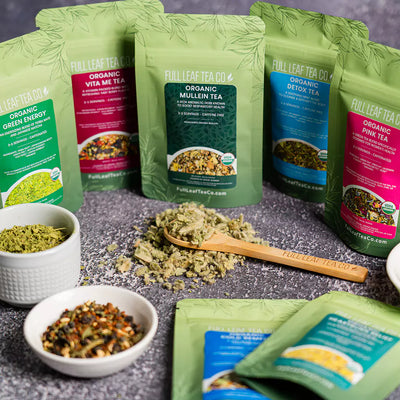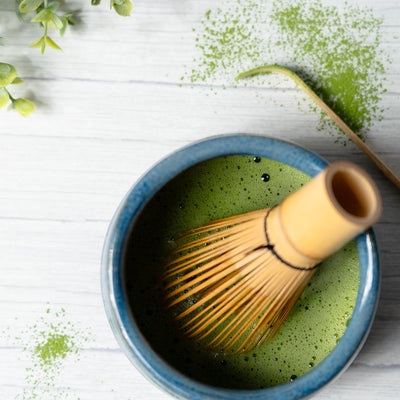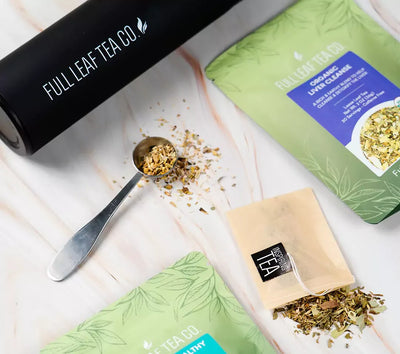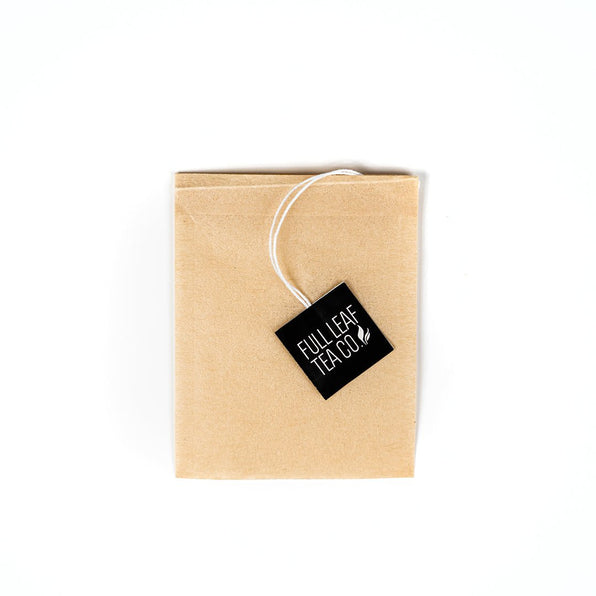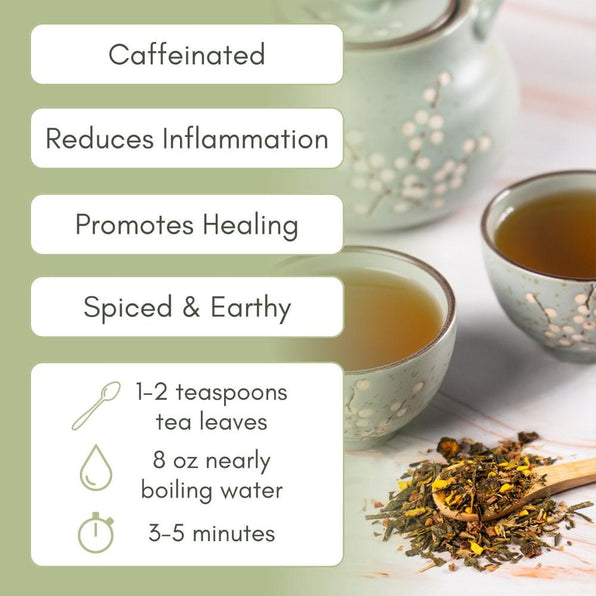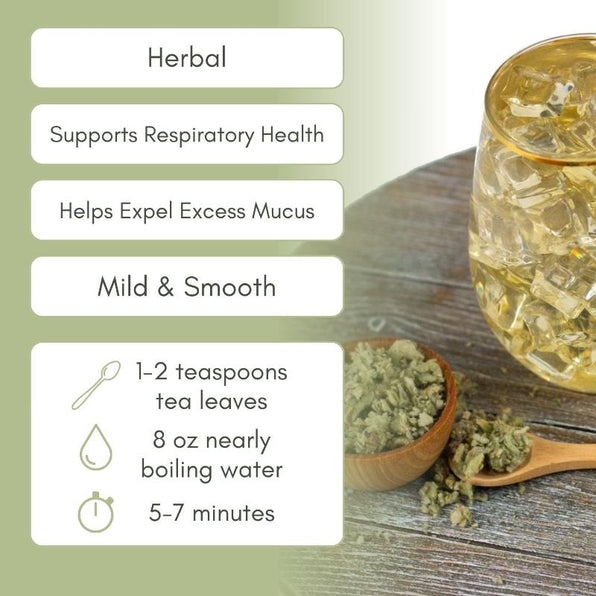Give Your Tea a Second Life!
At Full Leaf Tea Company, we’re all about reducing waste and embracing the natural versatility of tea. If you’re wondering what to do with your used tea leaves, we’ve got you covered! Here are seven easy and rewarding ways to reuse your tea leaves (and herbal blends!)—plus specific recommendations from our collection to get the best results.
1. Feed Your Garden
Why it works: Tea leaves are rich in nitrogen and can improve soil structure, retain moisture, and help deter pests like slugs and ants.
How to do it:
After steeping, allow the tea leaves to cool completely.
Sprinkle directly around the base of plants or mix into your compost bin.
For indoor plants, mix a small amount into potting soil or apply as a mulch layer.
Best teas and herbs to use:
Organic Green Tea – Mild and nutrient-rich, perfect for delicate plants.
Organic Oolong Tea – Great for outdoor gardens, especially acid-loving plants.
Organic Peppermint – Helps repel bugs naturally.
Organic Dandelion and Ginger Root – both of these herbs can enrich compost with trace minerals.

🌿 Pro tip: Roses, ferns, and potted plants especially love used green and black tea leaves!
2. Freshen Up Your Home
Why it works: Tea leaves are natural odor absorbers and can be used as a zero-waste alternative to baking soda.
How to do it:
Dry used leaves thoroughly on a towel or baking sheet.
Place in breathable fabric pouches or small bowls.
Use in shoes, trash bins, refrigerator shelves, or even in the car!

Best teas to use:
Organic Earl Grey – The bergamot scent lingers beautifully in small spaces.
Organic Lemon Ginger Mate – Refreshing and zesty; great for kitchens and bathrooms.
Organic Mint Bliss – Invigorating peppermint and spearmint neutralize unpleasant smells.
🧦 Bonus tip: Add a few drops of your favorite essential oil to the dried leaves for a homemade drawer sachet.
3. Clean Glass and Mirrors
Why it works: The tannins in black and green teas help cut through grease and leave a streak-free shine.
How to do it:
Re-steep used leaves in hot water (1–2 cups).
Let the tea cool completely.
Pour into a spray bottle and use on windows, mirrors, and glass surfaces.
Wipe clean with a soft microfiber cloth.

Best teas to use:
Organic Black Tea – Strong tannins make this ideal for natural cleaning.
Organic Kingston Earl Grey – Adds a light citrus scent while cleaning.
Organic Green Energy – Antioxidant-rich and subtly astringent.
✨ Tip: Test on a small spot first if using on wood or colored surfaces.
4. Pamper Your Skin
Why it works: Used tea leaves still contain polyphenols and antioxidants that can refresh, exfoliate, and tone your skin.
How to do it:
Let tea leaves cool, then gently massage onto clean, damp skin in small circles.
For a mask, mix cooled leaves with yogurt or honey.
Rinse off after 5–10 minutes for a natural glow.

Best teas to use:
Organic Beauty Me Tea – Formulated with burdock root, rose petals, and gotu kola—perfect for skin health.
Ceremonial Matcha (used as a mask) – Brightens and tones.
Organic Chamomile Tea – Soothes redness and irritation.
💆♀️ Pro tip: You can also chill the used tea leaves and use them as a soothing under-eye treatment.
5. Neutralize Cooking Odors
Why it works: Tea acts as a gentle deodorizer when simmered, helping clear the air after cooking strong-smelling meals.
How to do it:
Simmer used tea leaves in a small pot of water for 15–20 minutes.
Add optional extras like orange peels, cloves, or cinnamon sticks.
Let the scent refresh your space naturally.

Best teas to use:
Organic Blood Orange Black – Bright citrus notes are ideal for kitchen use.
Organic Herbal Chai – Naturally spicy and warm; perfect after frying or roasting.
Organic Turmeric Ginger Mate – Earthy, spicy, and great for balancing strong food odors.
🍊 Kitchen tip: Keep a sealed jar of dried used tea leaves and add to the simmer pot as needed.
6. Craft a Tea-Infused Bath
Why it works: Herbal teas are full of skin-soothing compounds and make for a relaxing, fragrant soak.
How to do it:
Re-steep used leaves in 4–5 cups of hot water, strain, and pour the liquid into a warm bath.
Alternatively, bundle tea leaves in cheesecloth or a muslin bag and drop them directly into the tub.
Best teas to use:
Organic Sleeping TranquiliTea – A calming blend of chamomile, peppermint, and lavender.
Organic Chamomile Tea – Known for relaxing both muscles and the mind.
Organic Lavender – Wonderful for a bedtime soak.
Organic Hibiscus Tea – High in vitamin C and great for skin tone and hydration.

🛁 Self-care tip: Add Epsom salts or a few drops of essential oils for an enhanced spa-like experience.
7. Polish Wood Surfaces
Why it works: Dark teas can add subtle color and shine to wood while helping clean dust and grime.
How to do it:
Re-steep dark tea leaves in hot water (1–2 cups).
Cool and dip a soft cloth into the tea.
Wipe down wooden tables, floors, or shelves.
Buff with a dry cloth to restore luster.
Best teas to use:
Organic Black Tea – High tannin content gives wood a lovely warm glow.
Organic Chai Tea – Adds a light spiced scent while reviving wood furniture.

🪵 Note: Avoid using on light or unfinished wood. Always test in a small area first!
Final Sip
Loose leaf tea isn’t just a drink—it’s a lifestyle! These creative reuse ideas let you extend the life of your tea, reduce waste, and discover new ways to enjoy the natural benefits of every blend. Whether you're pampering your plants or your skin, tea leaves are far too valuable to toss.
Have your own creative way to reuse tea leaves? We’d love to hear it! Share with us on Instagram or Facebook and tag @FullLeafTea.

